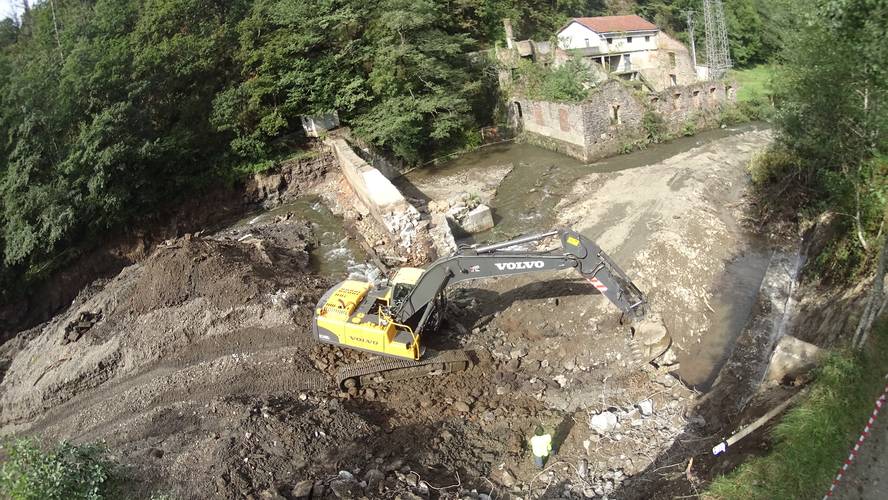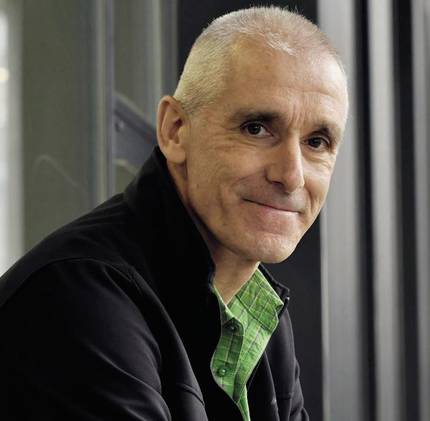Fluvial barrier clearance
The river is flow, it's transportation, it's movement, it's life. River ecosystems are one of the most diverse and threatened ecosystems. Since the beginning of the construction of mills and mills, humans have placed and placed obstacles to the flow and life of rivers. It is time to break down these obstacles.
In the European rivers there are 1.2 million obstacles charged in the bens, almost a barrier per kilometre (0.74 in particular). Most are prey, some large, but mostly small. 70% of the obstacles invented are structures with a height of less than two meters. And most of them no longer have any function, but they have a lot of influence on the river and on the life of the river.
The river flows and transportation does. “They are transportation systems,” as defined by Arturo Elosegi Irurtia, an UPV ecologist. “As they carry water, they move the sediments. And all its inhabitants have to move from top to bottom.”
The situation of these inhabitants is not easy in current rivers. “Rivers have always been used for social needs,” explains Arantza Unzurrunzaga Iturbe, Engineer of Hydraulic Works of the Provincial Council of Gipuzkoa. “And infrastructures like mills, ferreries and walls have been built in the rivers for a long time, and other structures like side walls have also buried the river, which has given the river a lot of artificiality. In some places it is not the river, but the canal, and it is totally different.”
This is one of the main problems that rivers currently have. And the European Biodiversity Strategy states that by 2030, 25,000 km of channels must be opened, bringing down dams and obstacles. In Euskal Herria, we have had years. “The Government of Navarra and the Provincial Council of Gipuzkoa, who are quite pioneers in Europe, have worked fundamentally,” says Elosegi. “Gipuzkoa, for example, made a filtration plan about 20 years ago and more than a hundred dams have been removed.”
“In its day we began to carry out sanitation to improve water quality, etc. And the next step we are taking is the recovery of the potential of the river,” says Unzurrunzaga. “And for this we are removing the transversal walls to the rivers.”

Cleaner water
The results have been work on improving water quality. “In the Basque Country, water quality was generally much worse 40-50 years ago, Elosegi explains. “Many rivers had neither fish nor almost alive. And that has improved a lot.” However, pollution remains a problem. “Now there are fish, but that doesn’t mean they’re OK. Although it’s not as serious as it was before, we now have more complex pollution, drugs, new pollutants… We have a worrying cocktail of pollutants.”
“Physical habitat has worsened,” says Elose. “Especially the Cantabrian rivers have been heavily channeled and the valleys have been fully urbanized. And there are still a lot of dams left. When the streams were almost dead, it didn't make much sense to start removing the dams. But today, once these serious chemical problems have been solved, dams are one of the main limiting factors.”
Demolition of dams is therefore key to river recovery. “The wall is what makes the river lose its balance,” explains Unzurrunzaga. “The solids don’t pass, they miss phases of the process, worsening water quality.”
In addition to hindering the movement of fish and living things, dams create an artificial habitat. “This inert space on the prey can please people, but not the inhabitants of the area,” explains Elosegi, where there are more alien species than native ones.
“Small dams increase the risk of flooding,” adds Elosegi. “As the water level rises a couple of meters, when heavy rains arrive, the river begins to grow and sink areas that would otherwise not be flooded.”
Enobieta landmark
Among the demolition works of the dams carried out in recent years, the drainage of the Enobieta dam at Artikutza has been a milestone. It is one of the largest withdrawals in Europe. She was evacuated in 2019. The wall has not yet been demolished and it has not been decided whether it will be demolished in full or only in part. The Spanish Government has the last word. The dam owner is the City Hall of Donostia-San Sebastian, which proposes to open a central section of 7 meters width in which the rest is deposited due to the environmental impact of the evacuation of all Artikutza waste.
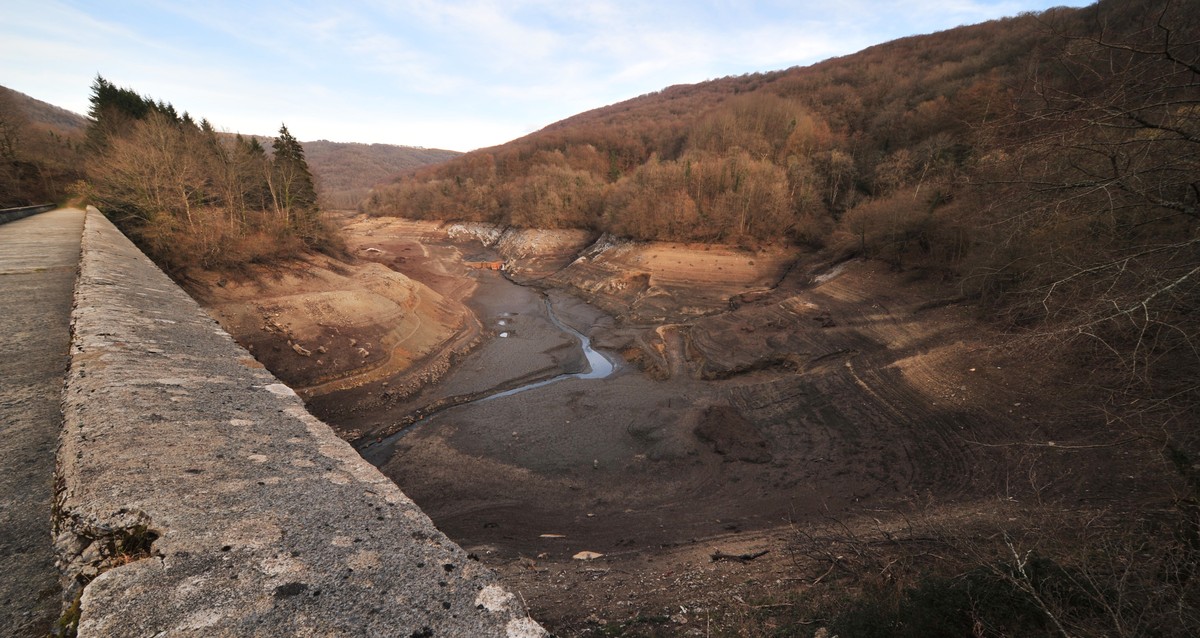
Elosegi’s team investigates the consequences of emptying the dam: “For the time being, what we have seen is, on the one hand, that the drain has hardly had any negative effects, some of which it could have had, but has hardly had any. And on the other hand, that the recovery is being very fast, both below and above the dam, the river is in much better condition than before.”
“We think this is an interesting lesson, because dams last, they are not forever,” Elosegi says. The anger guy lost his role long ago and was completely obsolete. “Many rushes are aging and not only do they harm the environment, but they have other risks. If exploited, for example, they would adversely affect the inhabitants and infrastructure of the surrounding area.”
Ten dams in Deba
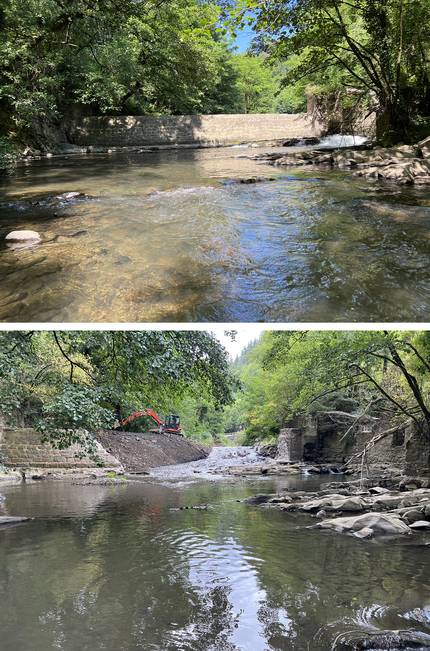
Elosegi and Unzurrunzaga are working on the Merlin project. The aim of this project is the regeneration of rivers and wetlands at 18 points in Europe. One of those places is the River Deba. The main course, between Arrasate and Deba, has ten disused dams that are intended to be removed. Four have already been removed.
“This project is a very nice example of seeing, even small dams, how different rivers are before and after these actions,” says Unzurrunzaga. “You notice in traffic, there’s more oxygenation… People also see where there was a well before now there’s a river.”
In all cases there is no complete demolition of the dams. Sometimes it is a heritage to be preserved, in which case the solution is to demolish only one part, for example the central part to allow water to pass and keep both ribs.
The case of each dam needs to be studied. “A geotechnical study is carried out to study the possible consequences of the elimination of the dam, taking into account the ecological importance of the river, archaeologists study whether it is a good to preserve, etc.”, explains Unzurrunzaga. “We work with geologists, biologists, archaeologists, chemists, lawyers, etc.”
The Elosegi team continues to investigate the environmental consequences of removing these dams: “We are measuring its impact on fish, invertebrates, water quality, ecosystem functioning, etc.”
Twenty-five dams in five rivers
And another river regeneration project has just been launched: Cantabrian. Its objective is to liberate 85 kilometres in five rivers of the Basque Country, Oria, Urumea, Urdazubi/Urdax, Errobi and Bidasoa, breaking down 25 obstacles and permeating another 7. In addition to removing obstacles, they will work to recover indigenous species (Serbian, European mink, salmon…) and to combat invasive species (American mink, tale…). “It’s an ambitious, very interesting and optimistic project,” says Unzurrunzaga. “It is a good opportunity to boost river recovery and comply with European legislation.”
The Zabalik project already existed, in which 11 dams were removed in the Bidasoa and Leitzaran. “The rivers of the Kantauribai and Zabalik project are one of the cleanest rivers in the Basque Country with salmon and with it,” says Elosegi. “Must is not in this situation. There is no salmon, there is no eel and there are many problems… They are quite different projects in that sense.”

In fact, the prey started to melt in the most critical places for the first salmon. “Then the governments of Gipuzkoa and Navarra began to realize that this had to be done elsewhere,” says Elosegi. “There were major controversies about the elimination of Endarlatza and Bera dams. Some fishermen were very opposed at first. But then they also realized that this would favor salmon. And in Bera, you've seen that they're now much better off in times of flooding. We think it is a message that is gradually being transmitted”.
“But it’s not always easy,” he continues. “I think the clearest example is Elizondo. The Txokoto dam is located in the centre of the village. And it causes huge problems in flooding.” The damage caused by 1913 forced the demolition of the church, for example. “And yet, locals like it.” Also visitors. It is part of the landscape of Elizondo, present in all photographs, iconic. “The fact is that if this landscape produces such ecological, economic and social damage, it is something we have to think about.”
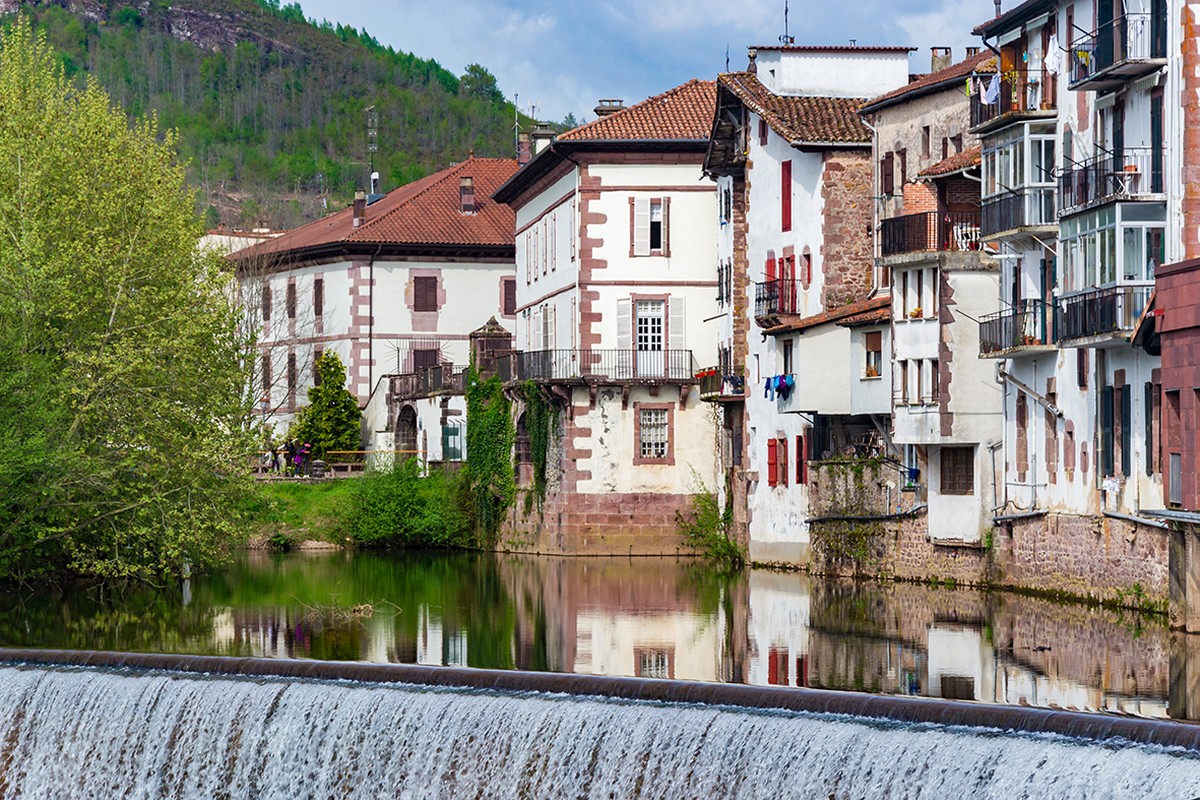
Reservoirs are not lakes.
There is often a misperception behind the resistance to removing dams. We see a lake where the reservoir is located. “In the case of anger, many also saw a nice lake and most continued to bet on keeping the prey,” says Elosegi. “But when he explains to you that this is not a lake, but a reservoir, that are very different, that have a different functioning, that have a very different ecological value, that release water of very different quality, then the perception changes. And I would say that now no one who has followed Enobieta a little is against it being taken away.”
Elosegi and Unzurrunzaga consider it essential to work on this issue in society. “It is very important that society recognizes these actions,” says Unzurrunzaga. “The changes are scary and normal, especially when it touches you close. Even when we started with sanitation, there were a lot of people saying what to do to spend public money. And now it is the citizens who see a leak. Society advances and demands another kind of river, the river.”
“Still, we have to better explain what a river is,” says Unzurrunzaga. The Merlin project is making a great effort. “We’ve held many workshops to explain to the public what our plans are, how they see them themselves and find agreed solutions,” explains Elosegi. “Sometimes it happens that citizens also show us values that we did not see and should be preserved.”
At the moment, in general, there has been little resistance in places where dams have been removed. “At some point they saw some problem, initially because they thought they benefited biodiversity or served to cope with the flood risk,” says Elosegi. “But when we told them they have an entirely opposite effect, they were in favor of elimination.”
The demolition of dams is good for the river and its ecosystems, but also for the population. “Damage from flooding is increasing. And in particular, these small dams in urban areas considerably increase the risk of flooding. There are known cases: In Elgoibar, for example, 50 years ago, the entire river was prepared and damaged in the floods. Since then all the dams have been removed and now it works a lot better.”
On the other hand, as Unzurrunzaga points out, “our right is to enjoy the river and with these actions we improve its quality, recover the river”.
“In general, welcoming is being very good, people are very optimistic about these actions,” says Unzurrunzaga. Elosegi agrees: “The citizens thank us for taking it into account.”
Next steps
Once the dams have been dismantled, experts are clear as to where river recovery should be followed: “Recover, as far as possible, the banks,” says Unzurrunzaga. “We have reduced the surface of the rivers, removed the margins and built infrastructures for the passage of the rivers, which is not the river. The recovery of the banks is very difficult in many places, but at least so that we do not continue to lose and where possible we must start to recover them.”
“The river should be connected to its flood plain, where it should be a natural forest, which would often be flooded,” explains Elosegi. In the Basque Country, recovery work is very timely. It is being done elsewhere. “In the Netherlands, for example, great works are being done on the Rhin River,” says Elosegi. “They are very clear that the best way to deal with floods is to let the river leave in some areas, where it is less damaged, so that in others it does not do more harm.”
Unzurrunzaga is hopeful, though she confesses it will take: “The river is slowly recovering. And the actions so far are very positive. In this way, it will be humanity itself that requests it.”
Lessons learned
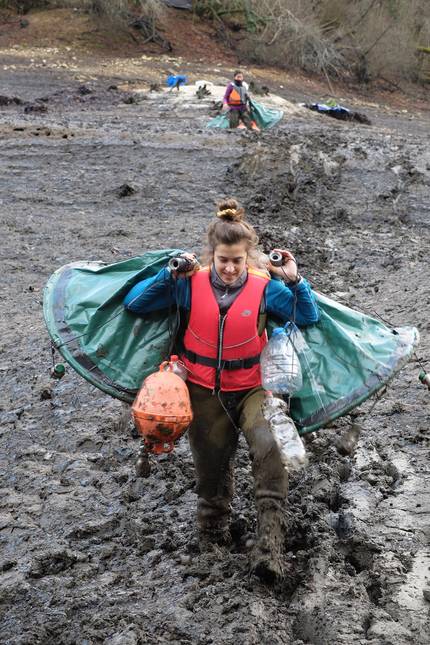
The results obtained so far also allow optimism. “At first it was thought that it was very difficult to remove the dams and it is becoming technically easier,” explains Elosegi. “In addition, there was concern about what would happen to cumulative sediments, and we have seen that they cause hardly any damage. And the river regenerates itself in a very short time. For example, in some areas vaguada jumps are planted, because here we feel that it is not necessary because as he comes at an incredible speed. We’ve seen it in the anger, how fast the forest comes in what was the reservoir.”
Another issue that has been removed from the demolition work of dams is the importance of social inclusion: “People’s views must be understood and taken into account,” says Elosegi. The same has been stressed by Unzurrunzaga: “We are working many professionals on river recovery. It is teamwork in which social presence is important. We need a society to form a team.”
Much remains to be done. “We have eliminated very few dams in Europe,” Elosegi said. “And, of course, it’s not about eliminating all the hurdles. We need urgency and in the future. But, on the one hand, we have to perpetuate to the maximum those we have and, on the other, eliminate those who have lost their function.”



